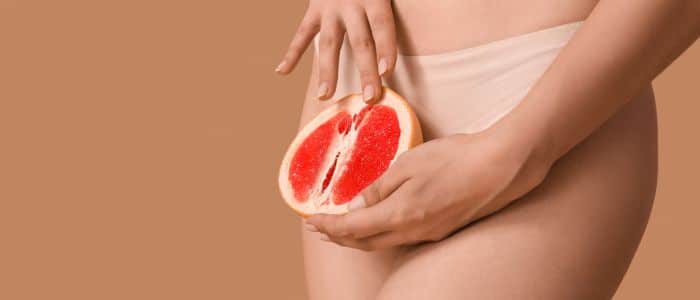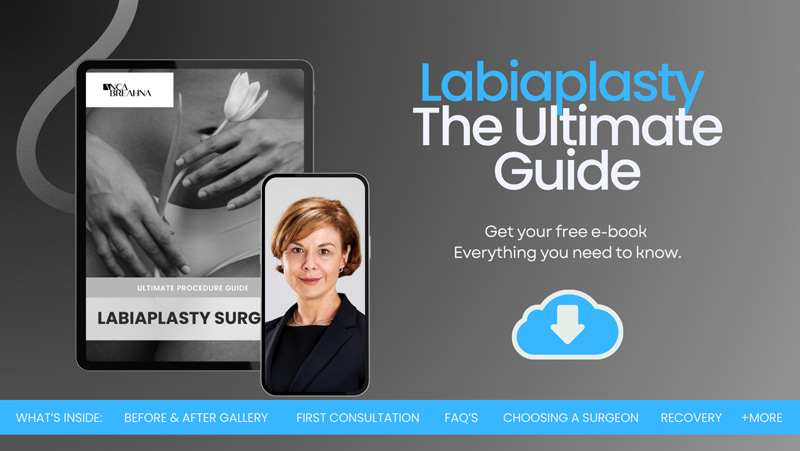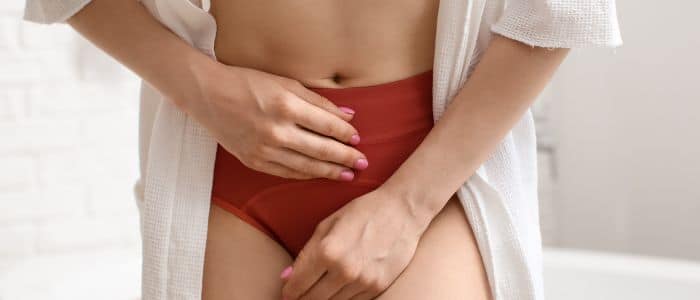
Expert Advice for Reducing Labial Size
When considering physical changes, understanding your body’s anatomy and its variations is important. The labia are a fundamental part of female genital anatomy, but their size can vary significantly from one person to another, often leading to physical discomfort or personal concerns about appearance. In this blog, Consultant Plastic Surgeon Anca Breahna aims to provide information about labial size, specifically for those exploring ways to reduce larger labia.
Take our Plastic Surgery Quiz to find out if you’d be a good candidate for cosmetic surgery.
What Causes Larger Labia?
The size of one’s labia can be influenced by several factors, primarily genetic. Just as other body parts vary among individuals, so do the labia. Hormonal changes during puberty and pregnancy can also cause changes in labial size and elasticity. Moreover, experiences such as childbirth and natural changes due to ageing can lead to longer or more elastic labia over time — a common concern among mums considering labiaplasty after childbirth.
Why Consider Reducing Labia Size?
For some, larger labia can lead to practical issues such as irritation while engaging in sports or other physical activities, discomfort when wearing tight clothing, or challenges in maintaining hygiene. These issues might prompt you to explore options for reducing the size of your labia. Moreover, feelings about one’s labia can influence personal views on appearance during intimate situations, leading to discomfort or avoidance of intimacy.
Assessing the Need for Labial Reduction
Determining whether to pursue labial reduction involves personal considerations and, in some cases, medical advice. If physical discomfort affects your daily activities, or if maintaining hygiene is a persistent challenge, these might be practical reasons for considering labial reduction. Consulting with a plastic surgeon can help clarify whether your concerns are best addressed through physical alterations or other management strategies. It is also essential to think about your expectations and discuss these openly with Anca to ensure that any decision made is based on a complex understanding of the potential outcomes and benefits.
Non-Surgical Methods to Manage Discomfort Caused by Large Labia
Choosing the right type of clothing is a simple yet effective approach. Opt for loose-fitting trousers and skirts, and avoid materials that irritate your skin. When it comes to underwear, breathable fabrics like cotton can reduce irritation and provide comfort. Additionally, maintaining impeccable hygiene can help alleviate discomfort. Gently washing the area daily with mild, unscented soap and water is advised. If moisture is a concern, unscented intimate wipes can be used during the day for quick refreshment. Lastly, there are topical treatments available that can reduce irritation and discomfort.
Exploring Surgical Options – Labiaplasty
Labiaplasty is a surgical procedure aimed at reducing the size of the labia minora, the inner folds of the vulva, to relieve discomfort or achieve a desired aesthetic appearance. The procedure involves trimming excess labial tissue to reduce its size or reshaping the labia to achieve symmetry. Before considering surgery, it is important to consult with Anca. She will evaluate your physical health, discuss your goals, and explain the potential outcomes and risks associated with the surgery.
There are several techniques Anca may use in labiaplasty, depending on the desired outcome and your anatomy:
Trim Technique
The trim technique is the most commonly used method in labiaplasty due to its simplicity and effectiveness. In this procedure, Anca trims away the excess labial tissue along the edge of the labia minora. This is particularly beneficial for those who have uneven or elongated labia minora that extend beyond the labia majora. The goal is to create a more uniform edge that does not protrude, which can significantly reduce physical discomfort caused by friction from clothing or during physical activities.
The procedure is relatively straightforward. It involves a linear incision along the edge of the labia minora, and the excess tissue is removed in a straight line. This approach allows for precise control over the amount of tissue being removed and ensures that the final appearance is neat and symmetrical. However, it typically results in a linear scar along the trimmed edge. Although this scar is usually thin and can fade over time, it is something that you need to consider. The trim technique is often chosen for its predictability and the relatively quick recovery time associated with it.
Download the Labiaplasty Guide

Wedge Technique
The wedge technique offers a different approach by focusing on maintaining the natural border of the labia minora while reducing its overall size. In this method, a pie-shaped or V-shaped wedge of tissue is removed from the thickest part of the labia minora. The remaining edges are then meticulously sutured together. This technique can maintain the natural wrinkled edges of the labia, which some find aesthetically desirable.
One of the significant advantages of the wedge technique is its potential to preserve the sensory nerves in the labia, which might reduce the risk of decreased sensation post-surgery. By keeping the incision away from the labial edge, the nerves that run along the periphery may be less likely to be damaged. This method is particularly suited for those who are concerned about maintaining natural labial sensation while achieving a reduction in size. It’s important for you to discuss with Anca whether this technique is appropriate for your anatomy and desired outcome.
Central De-epithelialisation Technique
The central de-epithelialisation technique is a less common but effective approach for those looking to decrease the volume of the labia minora without altering the natural borders or the overall length excessively. During this procedure, Anca removes a strip of tissue from the central portion of each labia, keeping the incision away from the outer edges. This method focuses on thinning the labia rather than shortening them, which helps preserve the natural folds and contours of the labia minora.
This technique is advantageous for those who may have thicker labia minora but do not necessarily have excess length. It reduces bulkiness and can improve comfort without significant visible scarring, as the incisions are made away from the edges and are concealed within the natural creases of the labia. The preservation of the outer edges also helps to maintain the original aesthetics of the labia, making this option attractive for patients seeking minimal alterations to appearance while still addressing functional concerns.
Each of these techniques has its specific indications, benefits, and potential drawbacks. It’s important for you to have a detailed discussion with Anca about the differences between these techniques and how they align with your anatomical needs and aesthetic goals. The choice of technique will largely depend on your existing labial anatomy, the amount of reduction desired, and your personal preferences regarding scars and sensation preservation.
Preparing for Labiaplasty
Choosing a qualified surgeon is the first step in preparing for labiaplasty. Look for professionals with specific training and a good track record in performing genital surgeries. During your consultation, be prepared to discuss your medical history, any medications you are taking, and your reasons for seeking the surgery. It’s important to have realistic expectations and a clear understanding of the potential outcomes. Anca will provide detailed pre-operative instructions, which may include avoiding certain medications or supplements that can increase bleeding during surgery. Emotional preparation is also significant. Understanding the recovery process and having a support system in place can help manage any anxiety related to the surgery.
The Labiaplasty Procedure
The labiaplasty procedure usually takes about one to two hours and is often performed under local anaesthesia with sedation or general anaesthesia, depending on the extent of the surgery and your comfort. During the procedure, Anca will carefully reshape or reduce the size of the labia minora as discussed during your consultation. The techniques used will depend on your anatomical structure and desired outcome but generally involve precise cutting and suturing to ensure minimal scarring and maintain the natural contour of the labia. Post-operative care instructions will be provided, which must be followed closely to ensure a smooth recovery.
Recovery from labiaplasty usually involves a few weeks of downtime, during which you may experience swelling and discomfort. It’s important to rest and avoid any strenuous activities, especially those that could put pressure on the surgical area, to facilitate healing. Ice packs can help reduce swelling, and pain relief can be managed with medications prescribed by Anca. Keeping the area clean and dry is important; follow Anca’s advice on how to bathe and care for the surgical site. Avoid sexual activity and the use of tampons for the time recommended by Anca to ensure that the area heals properly without complications.
Alternatives to Labiaplasty
For those unsure about undergoing surgery, there are alternatives that might help address concerns related to the appearance or discomfort of the labia. Non-surgical rejuvenation techniques, such as laser treatments, can help tighten the tissue and improve the overall appearance without the need for incisions or downtime. These treatments usually require multiple sessions and might not offer as dramatic results as surgery, but they can be a viable option for mild concerns.
FAQs about How to Get Rid of Large Labia
What are the risks of labiaplasty?
- Labiaplasty, like any surgical procedure, carries inherent risks that should be carefully considered before deciding to proceed. Common risks include infection, bleeding, and an adverse reaction to anaesthesia, which are typical of many surgical interventions. Specifically for labiaplasty, there is a risk of scarring, which can sometimes lead to aesthetic dissatisfaction or discomfort. Another significant concern is the potential for altered sensation in the labial region due to nerve damage during the procedure, which could impact sexual function or general physical sensation. Asymmetry is also a possible outcome, where the labia may not be symmetrical post-surgery, potentially necessitating further corrective procedures. You should discuss these risks thoroughly with Anca to fully understand the potential complications and how they can be managed or minimised.
How long does it take to recover from labiaplasty?
- Recovery time from labiaplasty can vary, but most patients are able to return to work and other normal activities within 5 to 7 days, provided these activities are not physically strenuous. Swelling and discomfort can last for a few weeks, and complete healing may take up to six months. Patients are advised to avoid vigorous exercise and sexual activity for approximately 4-6 weeks to allow the area to heal properly.
Can labiaplasty affect childbirth?
- Labiaplasty is generally performed on the labia minora and does not typically affect the vaginal canal or the ability to give birth. However, it is recommended to discuss future pregnancy plans with Anca during the consultation phase. If childbirth is expected in the near future, Anca may advise waiting until after you have finished having children to undergo the procedure, as childbirth can alter the results of labiaplasty.
Is labiaplasty covered by health insurance?
- In most cases, labiaplasty is considered a cosmetic procedure and is not covered by health insurance. However, if there are documented medical reasons for the surgery, such as chronic irritation, pain, or hygiene difficulties that cannot be resolved through other treatments, some insurance providers may consider partial coverage. It is important to check with your insurance provider and obtain any necessary pre-approvals or documentation from your surgeon that outlines the medical necessity of the procedure.
What should I look for in a labiaplasty surgeon?
- When choosing a surgeon for labiaplasty, it is important to select a consultant plastic surgeon who regularly performs female genital cosmetic surgery. Look for a surgeon with extensive experience in the specific procedure you are considering. It’s also beneficial to review before-and-after photos of their previous work to assess their aesthetic style. During your consultation, ensure that the surgeon takes the time to understand your goals, thoroughly explains the procedure, and discusses the potential risks and outcomes. Patient reviews and testimonials can also provide insight into their experience with the surgeon’s care.
Further Reading about Labiaplasty Surgery with Consultant Plastic Surgeon Anca Breahna
- Read more about Labiaplasty Surgery FAQs
- Read more about What is a labiaplasty?
- Read more about What Is a Labiaplasty or So-Called Designer Vagina?
- Read more about Labial Hypertrophy – Enlarged Labia
- Read more about How to Get Rid of Large Labia – Treatment Options
- Read more about Labiaplasty Types – Trim Labiaplasty and Wedge Labiaplasty or Hybrid
- Read more about Recovery after Labiaplasty
Medical References about Large Labia
- Labia Minora Hypertrophy: Causes, Symptoms – WebMD
- Labial hypertrophy: Causes, side effects, and treatment – Medical News Today
- Average Labia and Clitoral Length – News Medical
- Premenarchal labia minora hypertrophy – PubMed
- Labia Minora, Labia Majora, and Clitoral Hood Alteration – Oxford Academic


 Ms Anca Breahna, PhD, MSc, FEBOPRAS, FRCS (Plast) is a highly regarded Consultant Plastic Surgeon specialising in the field of Aesthetic and Reconstructive Plastic Surgery. Anca performs a range of
Ms Anca Breahna, PhD, MSc, FEBOPRAS, FRCS (Plast) is a highly regarded Consultant Plastic Surgeon specialising in the field of Aesthetic and Reconstructive Plastic Surgery. Anca performs a range of 